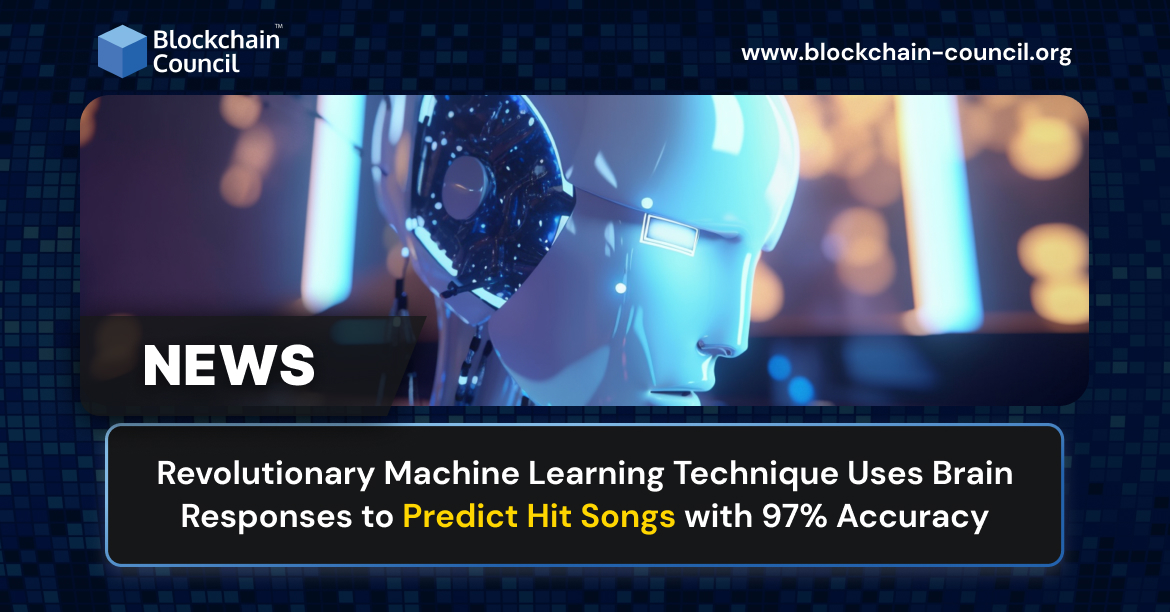
- Blockchain Council
- June 27, 2023
In a groundbreaking development, researchers in the United States have harnessed the power of machine learning and neurophysiological data to predict hit songs with an astonishing 97% accuracy rate. This breakthrough technique, known as “neuro forecasting,” offers a revolutionary approach to identifying popular music and holds the potential to transform the music industry.
The constant influx of new songs presents a significant challenge for streaming services and radio stations, which strive to curate playlists that resonate with a wide audience. Traditionally, these platforms have relied on a combination of human listeners and artificial intelligence to predict song success, but their accuracy rate has been stuck at a meager 50%. However, the advent of neuro forecasting has the potential to revolutionize this process by providing a more reliable and efficient method of identifying hit songs.
Led by Professor Paul Zak from Claremont Graduate University, the research team utilized machine learning techniques and neurophysiological data to predict the popularity of songs. Participants in the study wore off-the-shelf sensors while listening to a set of 24 songs. Their neurophysiological responses to the music were carefully monitored and analyzed. The brain signals collected reflected the activity of a brain network associated with mood and energy levels, providing valuable insights into market outcomes, such as the number of song streams.
Also read: Google & AI-powered Machine Learning Models Enhance Gmail Mobile App
The researchers applied various statistical approaches to evaluate the predictive accuracy of the neurophysiological variables. They discovered that a linear statistical model alone could identify hit songs with a success rate of 69%. However, when machine learning was applied to the collected data, the accuracy skyrocketed to an impressive 97%. Furthermore, the team also examined the neural responses to the first minute of the songs, achieving a success rate of 82% in identifying hits.
The implications of this research are far-reaching. Streaming services can leverage neuro forecasting to more efficiently identify new songs that are likely to become hits, simplifying their playlist curation process and ultimately delighting listeners. By tailoring recommendations based on individuals’ neurophysiology, future wearable neuroscience technologies could drastically reduce the overwhelming number of choices presented to consumers, offering them a more personalized and enjoyable music experience.
While the results of this study are highly promising, it is important to acknowledge its limitations. The analysis was conducted on a relatively small number of songs, and the demographics of the study participants were moderately diverse but not fully representative of all ethnic and age groups. Nonetheless, the researchers believe that the neuro-forecasting approach can extend beyond hit song identification and be applied to various other forms of entertainment, including movies and TV shows. The methodology developed in this study holds immense potential for reshaping how the entertainment industry predicts and delivers content.
Machine learning, a subset of artificial intelligence, plays a pivotal role in this groundbreaking research. It empowers computers to learn from data and make predictions or decisions without explicit programming. In the case of the neuro-forecasting technique, machine learning algorithms analyze the neurophysiological responses of participants to accurately predict the success of songs. The three main types of machine learning—supervised learning, unsupervised learning, and reinforcement learning—each serve specific purposes and are applicable in different scenarios.
Supervised learning involves training a machine learning model on labeled datasets, where inputs and corresponding outputs are provided, enabling the model to learn the relationship between features and labels. Unsupervised learning, on the other hand, deals with unlabeled datasets and focuses on discovering patterns or structures within the data. Reinforcement learning is an approach where an agent learns how to navigate an environment by performing actions and receiving rewards or penalties based on its performance. These machine-learning techniques have found applications in various domains, including image and speech recognition, medical diagnosis, natural language processing, and self-driving cars.
Also read:Machine Learning Vs Artificial Intelligence
However, as with any new technology, there are ethical considerations that must be addressed. The use of neuro forecasting raises concerns about privacy and consent. The collection of neurophysiological data requires the informed consent of participants, and strict measures must be taken to ensure the confidentiality and security of this sensitive information. Additionally, the potential for manipulating or exploiting individuals based on their neurophysiological responses raises ethical questions that need to be carefully addressed.
Furthermore, while neuro forecasting offers a powerful tool for predicting hit songs, it should not replace the creativity and diversity of the music industry. The subjective nature of music appreciation cannot be solely reduced to neurophysiological responses. The uniqueness and innovation that artists bring to their work should still be celebrated, as it is an essential aspect of artistic expression.
Looking ahead, the integration of neuro forecasting into the music industry holds immense potential. It could assist music creators in understanding how their work resonates with listeners and provide valuable insights for optimizing their compositions. Additionally, music platforms could utilize this technology to enhance user experiences by tailoring recommendations based on individual preferences and emotional responses.
As the field of machine learning continues to advance, we can expect further developments in neuro forecasting and its application in other areas beyond music. The ability to predict consumer preferences and market outcomes based on neurophysiological responses opens up new possibilities for personalized advertising, movie recommendations, and even product design.
The revolutionary technique of neuro forecasting, which combines machine learning and neurophysiological data, has shown remarkable accuracy in predicting hit songs. While there are limitations and ethical considerations to address, this technology has the potential to transform the music industry and provide a more personalized and enjoyable entertainment experience for consumers. As research in this field progresses, we can anticipate further advancements and applications in various domains, revolutionizing how we predict and deliver content.
Also read: The Ultimate AI Glossary: Unraveling the Jargon and Concepts of Artificial Intelligence





































































 Guides
Guides News
News Blockchain
Blockchain Cryptocurrency
& Digital Assets
Cryptocurrency
& Digital Assets Web3
Web3 Metaverse & NFTs
Metaverse & NFTs
